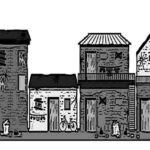THE ‘Great Stupa’ at Sanchi is the oldest stone structure in India and was originally commissioned by the emperor Ashoka the Great in the 3rd century BCE. Today, it is a UNESCO World Heritage Site. Its nucleus was a simple hemispherical brick structure built over the relics of the Buddha. It was crowned by the chatra, a parasol-like structure symbolising high rank, which was intended to honour and shelter the relics. It has four profusely carved ornamental gateways and a balustrade encircling the whole structure.
A Chunar sandstone pillar fragment, shining with the proverbial Mauryan polish, lies near Stupa I and carries the famous edict of Ashoka warning against schism in the Buddhist community. Stupa 1 was found empty, while relics of the two disciples of Buddha enshrined in the adjacent Stupa 3 were carried away to England. The nearby modern temple has a reliquary containing the remains of a Buddhist teacher from another Stupa outside Sanchi.

The Sanchi hill goes up in shelves with Stupa 2 situated on a lower shelf, Stupa 1, Stupa 3, the 5th century Gupta Temple No.17 and the 7th century temple No. 18 are on the intermediate shelf and a later monastery is on the crowning shelf. The balustrade surrounding Stupa 2, carved with aniconic representations of the Buddha, was added in the late 2nd century BC under the Satavahanas. The adjacent Gupta temple no.17 was hailed by Sir John Marshall as one of the most rationally organized structures in Indian architecture. Though small, it was a herald of all the principles which went into the engineering of an Indian temple in the early medieval period. The Buddhas in the perambulatory surrounding Stupa 1 are not contemporary with the Stupa but belong to the Gupta period in the mid-5th century AD. The monastery and the temple with the tall pillars adjacent to Stupa 1 and the temple near the monastery on the crowning shelf illustrate the evolution of the architectural form after the 5th century Gupta temple.
The Eastern Gateway depicts the young prince, Gautama leaving his father’s palace on his journey towards enlightenment and the dream his mother had before his birth. The western Gateway depicts the seven incarnations of the Buddha. The Northern Gateway crowned by a wheel-of-law, depicts the miracles associated with the Buddha as told in the Jatakas. The birth of Gautama is revealed in a series of dramatically rich carvings on the Southern Gateway.
The Archaeological Survey of India maintains a site museum at Sanchi. Noteworthy antiquities on display include the lion capital of the Ashokan pillar and metal objects used by the monks, discovered during excavations at Sanchi.































































